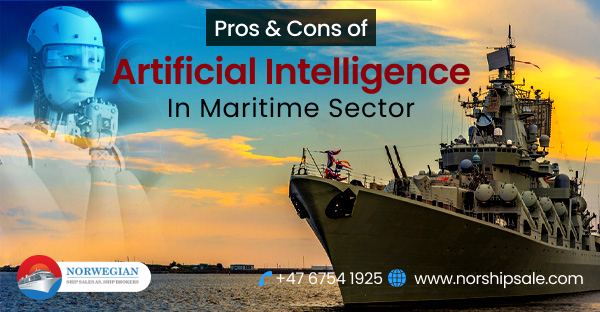Artificial Intelligence is rapidly making its inroads in the shipping industry. Maritime companies have been adopting advanced digitalization and AI technologies to run their daily operations. Artificial intelligence in the shipping industry helps to reduce errors, increase efficiency, and maximize profits. If you have been thinking about purchasing high speed vessels for sale, you must look at vessels that come with AI integration to keep up with the industry trend. But at the same time, one must also be aware of the drawbacks associated with AI.
In this blog, we look at the various pros and cons of using artificial intelligence in the maritime sector.
Advantages of AI
Advanced analytics
AI integration technologies streamlines the operational workflow, boosts productivity, and saves time. It allows businesses to make valuable insights based on multiple data sources across various platforms. This ensures all business decisions are taken on the basis of proven data analytics.
Automated equipment
Thanks to the advancement in AI technologies, modern shipping equipment relies heavily on automation and artificial intelligence. This type of machine learning can be useful by collecting past data, which helps to identify potential challenges. Automation allows the sipping crew to make changes as per the current weather patterns based on these learnings.
Increased safety and security
As explained above, artificial intelligence can be useful in predicting behaviors. This means that AI devices can also be used to predict bad weather patterns and reduce the risk of accidents. They are also helpful in detecting online threats and other malware.
Route optimization
AI technology can help ship captains in finding an optimized navigation route for their marine vessels. The new route is predicted based on various factors like weather conditions, fuel consumption, and maritime traffic.
Performance forecasting
AI can be used to predict the changes in vessel performance caused by underwater fouling. Historical data can be studied to learn the rate of degradation in the vessel performance.
Drawbacks of AI
Lack of reliable data
The analytic insights derived by AI are only as reliable as the data it receives. Since digitalization is still in its nascent stage in the maritime sector, there is often a lack of reliable data. Business decisions based on the insights taken from inaccurate data sources will result in poor decisions being made.
Fear of job replacement
This is one of the biggest concerns when it comes to adopting digital technologies in core maritime operations. Many feel that with newer technologies taking over some of the basic functions, it will lead to these old jobs being redundant. It is the responsibility of shipping companies to educate their workforce in learning new technology and explain its benefits to them. The industry needs to keep pace with the latest innovations to increase their profits.
Digital transformation costs
One of the main reasons why many companies are still behind on switching to digital technologies is because of the cost associated with the digitization of processes. There is an expenditure for installing and deploying the software, upgrading the hardware, training of the resource, time constraints, and other such limitations.
Conclusion
If you have been considering buying high speed vessels for sale, choose a ship that comes integrated with the latest technological advancements. Get in touch with Norwegian Ship Sales for a consult with professional shipbrokers.


